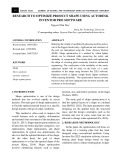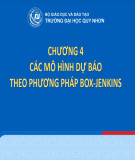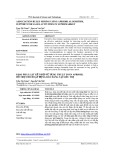
2
Height of a binary search tree sensitive to order
of insertions and removals
Minimum = log2(n + 1)
Maximum = n
Various search trees can retain balance despite
insertions and removals
Data Structures and Problem Solving with C++: Walls and Mirrors, Carrano and Henry, © 2013
3
FIGURE 19-1 (a) A binary search tree of
maximum height; (b) a binary search tree of
minimum height
Data Structures and Problem Solving with C++: Walls and Mirrors, Carrano and Henry, © 2013
4
CuuDuongThanCong.com https://fb.com/tailieudientucntt

3
A 2-3 tree not a binary tree
A 2-3 tree never taller than a minimum-height
binary tree
Data Structures and Problem Solving with C++: Walls and Mirrors, Carrano and Henry, © 2013
5
Placing data items in nodes of a 2-3 tree
A 2-node (has two children) must contain single data
item greater than left child’s item(s) and less than right
child’s item(s)
A 3-node (has three children) must contain two data
items, S and L , such that
S is greater than left child’s item(s) and less than
middle child’s item(s);
L is greater than middle child’s item(s) and less than
right child’s item(s).
Leaf may contain either one or two data items.
Data Structures and Problem Solving with C++: Walls and Mirrors, Carrano and Henry, © 2013
6
CuuDuongThanCong.com https://fb.com/tailieudientucntt

4
FIGURE 19-3 Nodes in a 2-3 tree: (a) a 2-node;
(b) a 3-node
Data Structures and Problem Solving with C++: Walls and Mirrors, Carrano and Henry, © 2013`
7
A 2-3 tree
Data Structures and Problem Solving with C++: Walls and Mirrors, Carrano and Henry, © 2013
8
CuuDuongThanCong.com https://fb.com/tailieudientucntt

5
Traverse 2-3 tree
in sorted order
by performing
analogue of
inorder traversal
on binary tree:
Data Structures and Problem Solving with C++: Walls and Mirrors, Carrano and Henry, © 2013
9
Retrieval operation for 2-3 tree similar to
retrieval operation for binary search tree
Data Structures and Problem Solving with C++: Walls and Mirrors, Carrano and Henry, © 2013
10
CuuDuongThanCong.com https://fb.com/tailieudientucntt



























